
Black rat snakes can make great pets as they’re not as complicated to care for as other snakes and have a good temperament. Whether you’re thinking about getting a black rat snake or you just want to brush up on your knowledge, read our care guide!
In this guide, we’ll go through the answers to the following questions so that you have all the information you need to care for a black rat snake:
- What do black rat snakes look like and how long do they live?
- How to set up and decorate a black rat snake’s enclosure?
- Which environmental parameters should be controlled in a black rat snake’s enclosure?
- How to clean a black rat snake’s enclosure?
- What do black rat snakes eat and how often?
- Are black rat snakes good pets?
- What are common health problems in black rat snakes?
Let’s see how to care for a black rat snake!
Table of Contents
Black Rat Snake Facts
We’ve listed some fast facts about black rat snakes below.
| Common name | Black Rat Snake, Pilot Snake, Western rat snake |
| Scientific name | Pantherophis obsoletus |
| Natural Habitat | Central and eastern United States |
| Adult size | 3-6 feet |
| Diet | Rodents, Reptiles, Amphibians, Small mammals, eggs |
| Lifespan | 15-20 years |
| Experience level | Beginner |
Where Do Black Rat Snakes Live?
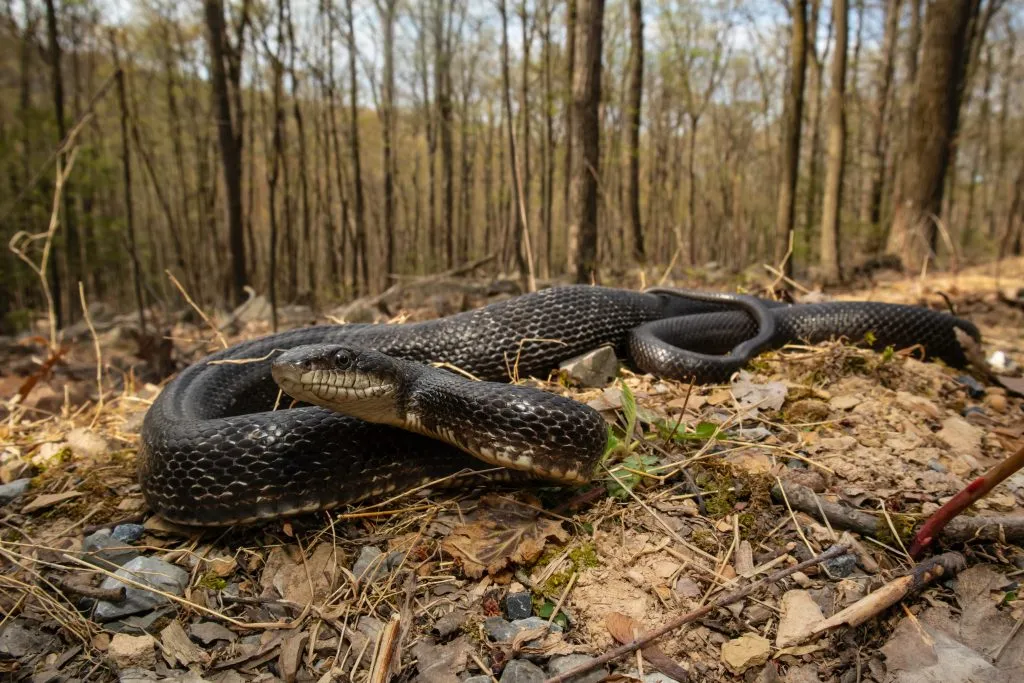
Black rat snakes can be found throughout the central and eastern united states where they are pretty common. Within these areas, you can find black rat snakes in forests, floodplains, rocky hills, farmland, and close to swamps.
You can also often see them in old buildings or barns and they’re usually the most common big snake within a suburban area.
Since wild black rat snakes eat rats, mice, and other pests but usually avoid contact with humans, they are good creatures to have around. Black rat snakes could even be considered natural pest control!
They constrict their prey to kill them and swallow them whole before digesting them slowly over a few days.
Black rat snakes are really good at climbing, we’ll talk later about how to facilitate this need for captive black rat snakes later.
Did you know that the black rat snake is the most widely distributed common rat snake? (source)
Black Rat Snakes Appearance And Colors
Unsurprisingly, black rat snakes are usually black on the top of their body. They also have small white areas in between some of their scales.
On the underside, they are whitish close to their head and this color becomes patterned closer to the tail.
There are also yellow and gray rat snakes, we’ve described their patterns below:
- Yellow rat snakes are yellow, green, or orange and have 4 dark stripes along their body
- Gray rat snakes are light to dark gray with darker brown or gray areas
Hatchling black rat snakes are lighter gray in color and have black blotches on their back. Interestingly, juvenile individuals of yellow and gray rat snakes, also have the same patterns as the black rat snake, so it could be harder to tell them apart when they’re young.
How Big Do Black Rat Snakes Get?
According to this study, adult rat snakes are usually between 3 and 5 feet long, but some snakes can be more than 6 feet long.
If you get your black rat snake as a hatchling or juvenile, it’s good to consider that you’ll need to upgrade the size of its tank as they grow.
Black Rat Snake Lifespan
In the wild, black rat snakes live between 10 and 15 years. In captivity, there are reports of them living over 30 years, though! (source)
In nature, their predators are owls, hawks, and foxes. Black rat snakes defend themselves from predators by:
- Imitating the sound of a rattle by vibrating their tail in dead leaves
- Expelling an unpleasant odor.
To help your pet black rat snake live as long as possible, ensure that you provide them with the best possible diet and husbandry conditions. We’ll explain how to do this in the next section.
How To Care For Black Rat Snakes
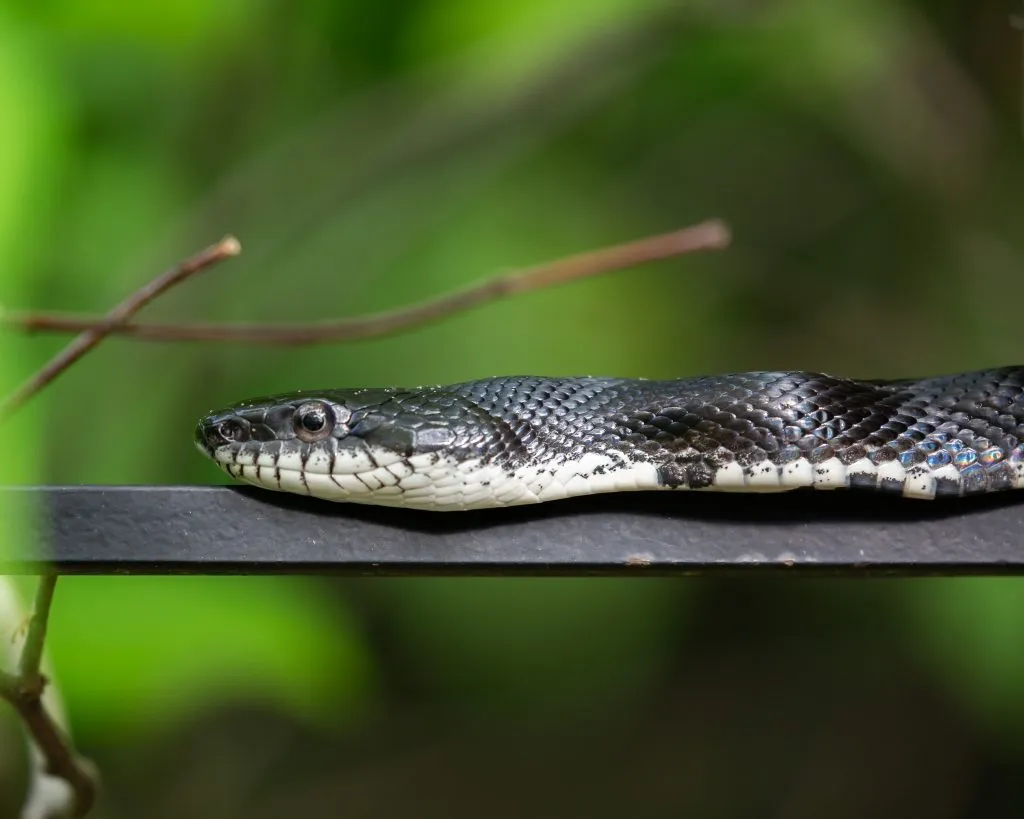
In this section, we’ll explain how to care for a black rat snake by going through how to set up and clean their
Below is a guide for items you’ll need to care for a black rat snake. We’ll explain how to use them later:
- 2 hides
- a substrate
- 2 thermometers
- a hygrometer
- UVB bulb (replaced every 6 months)
- A suitably sized secure
tank and lid - decorations such as branches and reptile-friendly plants
- a water bowl large enough for the snake to climb inside
Black Rat Snake Tank Setup
If you have a hatchling you can house them in a 20-gallon terrarium but when they’re an adult, you’ll need to put them in a 40-gallon terrarium.
Don’t forget that black rat snakes enjoy climbing, so make sure that their
It’s also important to provide a large water bowl that is big enough for your snake to climb into. It’s best to use a heavy water bowl that isn’t easily knocked over
It’s best to house only one snake per
Lighting And Temperature
A black rat snake’s terrarium needs to have a temperature gradient. One end of the terrarium should be a ‘warm’ end with a temperature of 80 to 85 degrees Fahrenheit and a basking area.
The opposite end of the
To help maintain an appropriate temperature during the day, use a 50-watt basking lamp (you might need more than one depending on the size of your snake).
It’s important to place the lamp outside the
Don’t forget to turn the heat lamp off at night so that the temperature can decrease similarly as to in nature. A drop in temperature of around 10 degrees Fahrenheit (around 75 degrees Fahrenheit) at night is appropriate.
If you live in a colder area, you might want to get a heat mat with a thermostat. This will help ensure the temperature doesn’t drop too much at night when you turn the heat light off.
Place a thermometer at each end of your snake’s
tank so you can monitor the temperature gradient.
When it comes to lighting, use a timer to give your snake 12 hours of light each day. The size of your snake and its
Do Black Rat Snakes Need UVB?
The use of UVB light can help keep your snake healthy. Use a UVB bulb on the outside of your snake’s
Make sure to replace the UVB bulb every 12 months and place the lamp outside the warm area of your snake’s
Substrate
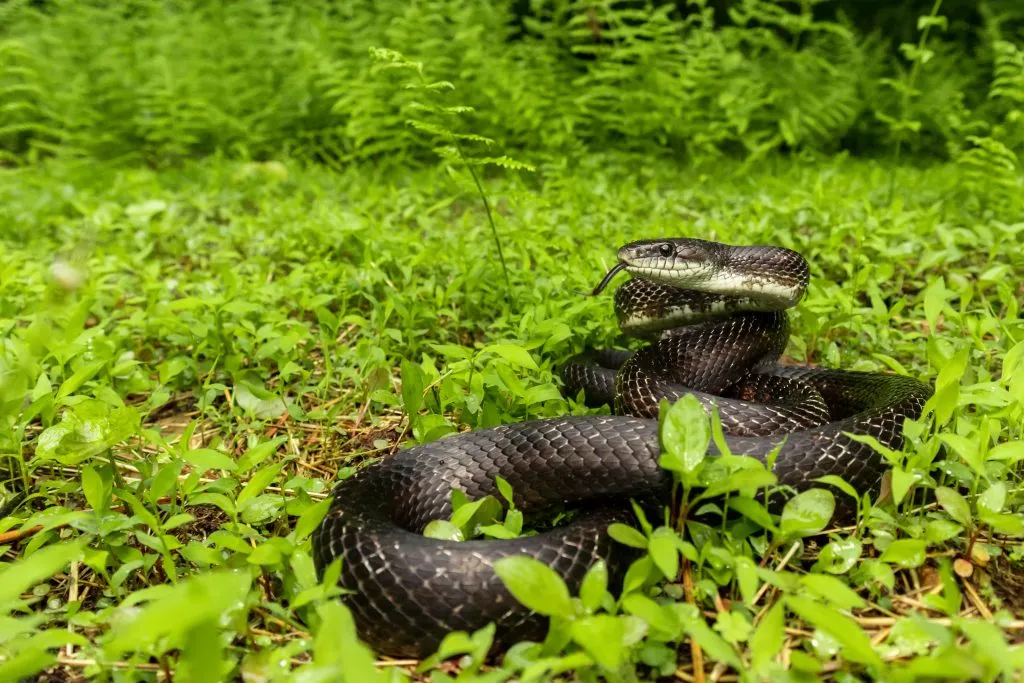
A substrate is an important part of your snake’s terrarium because it helps maintain an appropriate humidity level, keeps your snake comfortable, and allows them to perform its normal burrowing behavior.
Black rat snakes will especially appreciate a substrate that is similar to their natural environment. Your choice of substrate will also depend on the natural humidity level, where you live, and the time of year.
Examples of suitable substrates for black rat snakes include:
- aspen shavings
- reptile carpet
Humidity
The humidity level in your snake’s terrarium should be between 50% and 70%. Measure it using a hygrometer placed in the middle of the terrarium.
To help maintain the appropriate humidity, mist the
Don’t forget that humidity levels in your snake’s
It’s also good to create a moist hide for your snake with sphagnum moss for your snake to enjoy and to help with shedding.
Black Rat Snakes Tank Decor
Decorating your black rat snake’s
Examples of things you which can both provide enrichment for your black rat snake and decorate the
- moist hide with sphagnum moss
- dry hide at the opposite end to the moist hide
- branches
- reptile safe plants
How To Clean A Black Rat Snake’s Tank
Below we’ve outlined a cleaning schedule for a black rat snake’s terrarium:
- Every day – spot clean the
tank by removing feces, urates, and uneatenfood . It’s also good to check areas such as the moist hide for signs of mold. - Every week – clean the water bowl with reptile-safe disinfectant
- Every few months – remove and replace the substrate. Clean the entire and it’s components with reptile-safe disinfectant.
How To Properly Feed A Black Rat Snake
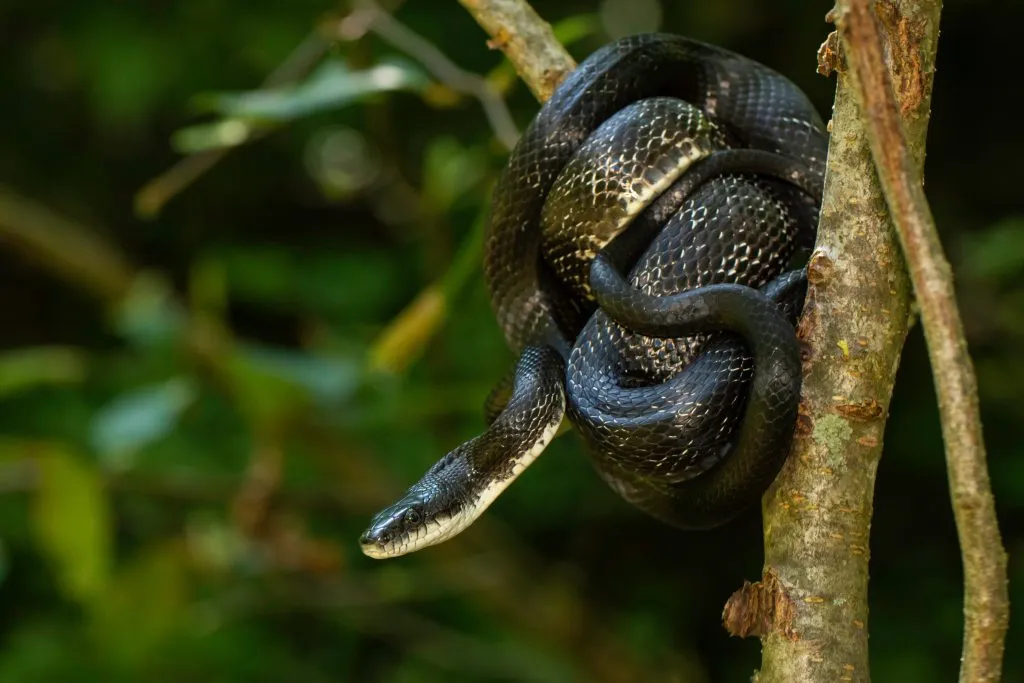
Wild rat snakes kill prey such as lizards, frogs, young rabbits or opossums, chipmunks, and rodents by constriction. In this section, we’ll explain how to feed a pet rat snake safely and appropriately.
What To Feed
Feed prey items that are no bigger than 1.5 times the size of the snake’s mouth or smaller than the widest part of the snake. This is important as your snake will only be able to digest appropriately sized prey items.
To keep things interesting for your snake and to help maintain a healthy appetite, feed a variety of dead animals such as:
- rats
- mice
- hamsters
- gerbils
- young chicks
You can buy the above from a reptile pet store and store them in your freezer. Make sure they are defrosted thoroughly before offering them to your snake.
Offering already killed prey is preferable as it’s much safer than giving a snake live animals. This is because live animals can bite and injure your snake.
To keep yourself safe during feeding time, offer your snake’s prey using specially designed reptile feeding tweezers.
How Often To Feed
Juveniles and hatchlings should be fed every 5 to 7 days. Adult black rat snakes should be fed every 1 to 2 weeks (source).
Don’t be surprised if your snake refuses to eat during shedding. This is normal and nothing to be worried about. We’ll talk about other reasons for a snake losing it’s appetite later.
How Long Can A Black Rat Snake Go Without Food ?
It’s best to feed a pet snake according to its age as we explained earlier.
Generally, snakes can survive a few months without eating (source) depending on factors such as age, health status, and the snake’s habitat. However, it’s not recommended to stop feeding your snake to test this theory!
If you’re unable to feed your snake as regularly as needed due to a holiday or other commitments, ask someone to do it for you. You can read more about this topic in our article ‘how long can snakes go without eating?’.
Do Black Rat Snakes Need To Drink Water?
Yes, black rat snakes need water to keep hydrated, keep healthy, and to help with shedding. As we mentioned earlier, keep a large bowl of clean and fresh water in their
Vitamins And Minerals
Pet snakes don’t usually need supplements such as extra vitamins or minerals if they have an appropriate diet and are housed correctly.
Speak with your reptile vet to check whether your pet might have additional needs in terms of its diet.
Black Rat Snake Behavior And Temperament

Black rat snakes are not venomous, although if they sense danger, they may strike. Once they’ve gotten used to you, black rat snakes are calm and easy to handle.
Don’t forget to take everything very slow and to pay attention to your snake’s behavior at all times to ensure that they’re comfortable.
Are Black Rat Snakes Good Pets?
Black rat snakes can be considered suitable reptile pets for less experienced keepers. They’re usually quite relaxed, and it’s possible to handle them regularly.
Don’t forget, although handling time can be fun, snakes shouldn’t be handled within 48 hours after eating, during shedding, or brumation. It’s also preferable to build handling time up gradually.
In terms of their care requirements and diet, they’re not too hard to cater to compared to other snakes. This means that they’re suitable snakes for less experienced keepers.
Black Rat Snake Common Health Problems
Health problems in captive reptiles are often related to inappropriate husbandry conditions. It’s important to always ensure that your snake’s
We’ve listed some common health problems in pet snakes below:
- Mouth rot (infectious stomatitis)
- Infections with bacteria, viruses, or fungi
- Skin problem or difficulty shedding (dysecdysis)
If you think your snake might be unwell, contact a reptile veterinarian for a proper diagnosis and treatment. We’ve listed some signs of possible health problems in pet snakes below:
- loss of appetite
- decreased activity
- noisy breathing
- weight loss
- abnormal feces or urates (read more about this in our ultimate snake poop guide)
- material exiting or surrounding the eye, nose, or mouth
- changes in the condition of the skin (healthy skin is smooth and shiny).
The above list should be used as a guide only. If you think your black rat snake might be unwell, contact a reptile veterinarian as soon as possible.
You can read more about illness in snakes in our article 10 signs that your snake is dying and how to help.
Where To Buy Black Rat Snakes
After reading all about how to care for a black rat snake, maybe you’ve decided that they’re a suitable pet for you. Let’s explore how to buy your black rat snake.
Black Rat Snake Breeders
Buying your pet from a breeder is usually preferable to buying them from a pet store. This is because you’re more likely to get a healthy individual who has been taken care of properly.
Breeders are also likely to offer you advice and guidance for the lifetime of your pet.
When choosing your black rat snake, look for the following signs to ensure that you’re buying a healthy individual:
- Bright, alert, and clear eyes
- Skin without color changes or injuries
- Awake and flicking their tongue
No matter how often you see a wild black rat snake, don’t be tempted to try and keep a wild animal as a pet.
Black Rat Snake Price
The price of a black rat snake can vary between $50 to $100 depending on their age, specific markings, and the breeder.
Black Rat Snake Breeding
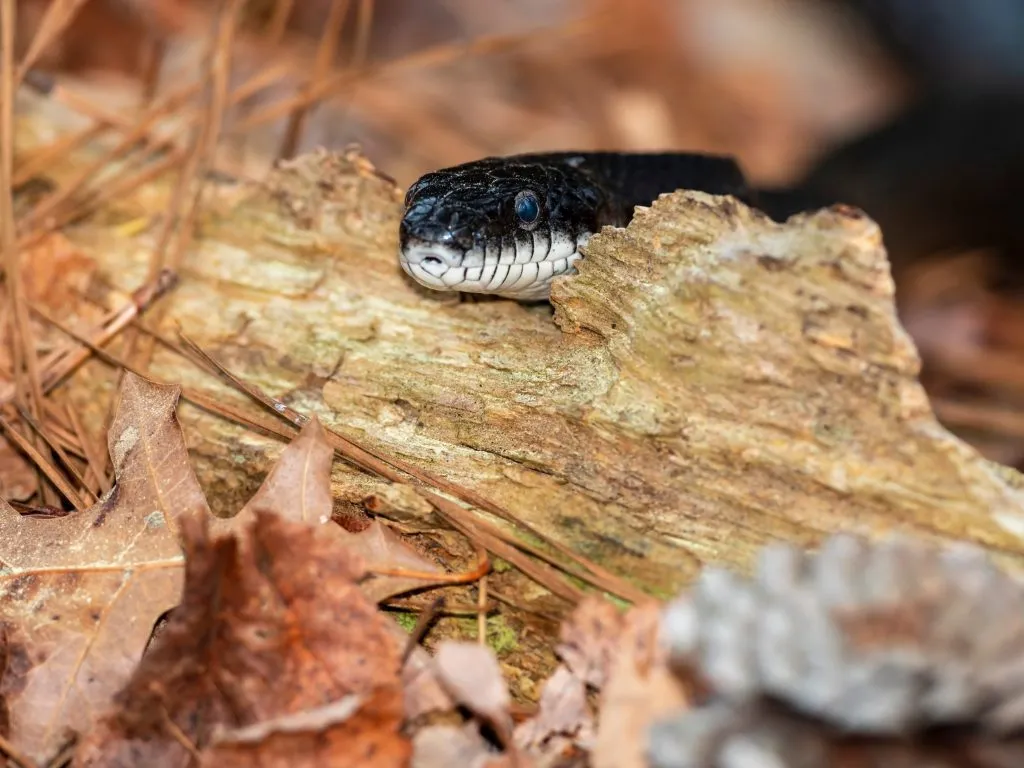
In the wild, black rat snakes stop hibernating between March and May and start looking for a mate between late April to June. Females take about 4 years to reach sexual maturity.
Male snakes use pheromones to indicate to females that they’re interested.
Approximately 5 weeks after mating, females lay and hide between 12 to 20 eggs in a hidden area, which hatch after around 65 to 70 days. Females can lay two clutches of eggs each year.
Newly hatched black rat snakes are around 12 inches long.
Conclusion
Black rat snakes are beautiful and interesting pets that can live for a long time if cared for properly.
If you’re interested in having a smaller or more common pet snake, read our care guides on DeKay’s Brown Snake and Ball Pythons.
- Enchi Ball Python: A Unique and Stunning Morph of Python regius - March 27, 2025
- Emerald Tree Monitor: The Enigmatic Green Guardian of the Rainforest - March 26, 2025
- The Egyptian Cobra (Naja haje): A Fascinating Serpent - March 25, 2025
